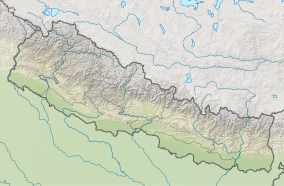Sagarmatha National Park
| Sagarmatha National Park | |
|---|---|
 Landscape in the national park | |
| Location | Koshi, Nepal |
| Nearest city | Namche, Khumjung |
| Coordinates | 27°56′N 86°44′E / 27.933°N 86.733°E / 27.933; 86.733 |
| Area | 1,148 km2 (443 sq mi) |
| Established | 19 July 1976 |
| Governing body | Department of National Parks and Wildlife Conservation |
| Website | sagarmathanationalpark.gov.np |
|
| |
| Criteria | Natural: vii |
| Reference | 120 |
| Inscription | 1979 (3rd Session) |
Sagarmāthā National Park is a national park in the Himalayas of eastern Nepal that was established in 1976 and encompasses an area of 1,148 km2 (443 sq mi) in the Solukhumbu District. It ranges in elevation from 2,845 to 8,848 m (9,334 to 29,029 ft) and includes Mount Everest. In the north, it shares the international border with Qomolangma National Nature Preserve in Tibet Autonomous Region. In the east, it is adjacent to Makalu Barun National Park, and in the south it extends to Dudh Kosi river.[1] It is part of the Sacred Himalayan Landscape.[2]
History

Sagarmatha National Park was established on July 19, 1976.[3] In 1979, it became the country's first national park that was inscribed as a Natural World Heritage Site. In January 2002, a Buffer Zone comprising 275 km2 (106 sq mi) was added.[1] Conservation of forests, wildlife, and cultural resources received top priority under the Buffer Zone Management Guidelines, followed by conservation of other natural resources and development of alternative energy.[4] Tourism in the area began in the early 1960s. In 2003, about 19,000 tourists arrived. As of 2005, about 3,500 Sherpa people lived in villages and seasonal settlements situated along the main tourist trails.[5]
Landscape
Sagarmatha National Park contains the upper catchment areas of the Dudh Kosi and Bhotekoshi rivers and the Gokyo Lakes. It ranges in elevation from 2,845 m (9,334 ft) at Monjo to the top of Mount Everest at 8,848 m (29,029 ft). Other peaks above 6,000 m (20,000 ft) are Lhotse, Cho Oyu, Thamserku, Nuptse, Amadablam and Pumori. Barren land above 5,000 m (16,000 ft) comprises 69% of the park while 28% is grazing land and the remaining 3% is forested. Climatic zones span from temperate and subalpine above 3,000 m (9,800 ft) to alpine above 4,000 m (13,000 ft), which is the upper limit of vegetation growth. The nival zone begins at 5,000 m (16,000 ft).[1]
Wildlife

Flora
The forests in the subalpine belt consist of fir, Himalayan birch and rhododendron. Juniper and rhododendron prevail at elevations of 4,000–5,000 m (13,000–16,000 ft). Mosses and lichens grow above 5,000 m (16,000 ft).[6] More than 1,000 floral species were recorded in the national park.[1]
Fauna

Sagarmatha National Park hosts 208 bird species including Impeyan pheasant, bearded vulture, snowcock and alpine chough.[1] It has been designated as an Important Bird Area.[7] Ungulates include Himalayan thar, Himalayan serow and musk deer. The snow leopard inhabits elevations above 3,500 m (11,500 ft), and the Indian leopard roams forests in lower elevations.[8]
References
- ^ a b c d e Bhuju, U.R.; Shakya, P.R.; Basnet, T.B. & Shrestha, S. (2007). "Sagarmatha National Park" (PDF). Nepal Biodiversity Resource Book. Protected Areas, Ramsar Sites, and World Heritage Sites. Kathmandu: International Centre for Integrated Mountain Development, Ministry of Environment, Science and Technology, in cooperation with United Nations Environment Programme, Regional Office for Asia and the Pacific. pp. 53–55. ISBN 978-92-9115-033-5.
- ^ Gurung, C. P.; Maskey, T. M.; Poudel, N.; Lama, Y.; Wagley, M. P.; Manandhar, A.; Khaling, S.; Thapa, G.; Thapa, S. & Wikramanayake, E. D. (2006). "The Sacred Himalayan Landscape: Conceptualizing, Visioning, and Planning for Conservation of Biodiversity, Culture and Livelihoods in the Eastern Himalaya" (PDF). In McNeely, J. A.; McCarthy, T. M.; Smith, A.; Whittaker, O. L. & Wikramanayake, E. D. (eds.). Conservation Biology in Asia. Kathmandu: Nepal Society for Conservation Biology, Asia Section and Resources Himalaya Foundation. pp. 10–20. ISBN 99946-996-9-5.
- ^ Centre, UNESCO World Heritage. "Sagarmatha National Park". UNESCO World Heritage Centre. Retrieved 2023-10-23.
- ^ Heinen, J. T. & Mehta, J. N. (2000). "Emerging Issues in Legal and Procedural Aspects of Buffer Zone Management with Case Studies from Nepal". Journal of Environment and Development. 9 (1): 45–67.
- ^ Byers, A. (2005). "Contemporary human impacts on Alpine ecosystems in the Sagarmatha (Mt. Everest) National Park, Khumbu, Nepal". Annals of the Association of American Geographers. 95 (1): 112–140.
- ^ Buffa, G.; Ferrari, C. & Lovari, S. (1998). "The upper subalpine vegetation of Sagarmatha National Park (Khumbu Himal area, Nepal) and its relationship with Himalayan tahr, musk deer and domestic yak. An outline". In Baudo, R.; Tartari, G. & Munawar, M. (eds.). Top of the World environmental research: Mount Everest–Himalayan ecosystem. Leiden, the Netherlands: Backhuys Publishers. pp. 167–175.
- ^ "Sagarmatha National Park". BirdLife Data Zone. BirdLife International. 2005. Retrieved 11 October 2020.
- ^ Lovari, S.; Boesi, R.; Minder, I.; Mucci, N.; Randi, E.; Dematteis, A. & Ale, S. B. (2009). "Restoring a keystone predator may endanger a prey species in a human-altered ecosystem: the return of the snow leopard to Sagarmatha National Park". Animal Conservation. 12: 559–570. doi:10.1111/j.1469-1795.2009.00285.x.
External links
- BirdLife International. "Important Bird Areas factsheet: Sagarmatha National Park".
- "Sagarmatha National Park". Department of National Parks and Wildlife Conservation, Nepal.
- Official UNESCO website entry


